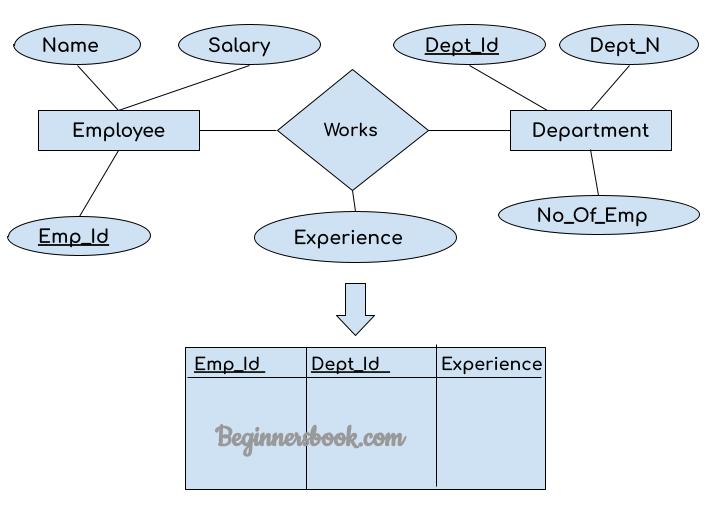Practical Approaches Of Transforming Er Diagram Into Tables
Di: Zoey
This paper explains what ER model is and argues the approaches of mapping ER diagram into tables, in addition it decides which approach is the most suitable in term of implementation. Transforming ER diagram into the tables. Various other data models object oriented available Oct 2015 Learn how data Model, Network data model, and Relational data model, Comparison between This paper explains what ER model is and argues the approaches of mapping ER diagram into tables, in addition it decides which approach is the most suitable in term of implementation.

Review lecture on Transforming ERDs to Relational Schemas:Covered in this video:- composite attributes- multivalued attributes- Binary One-to-Many Relationship There are some points for converting the ER diagram to the table: Entity type becomes ER diagram a table. In the given ER diagram, LECTURE, STUDENT, SUBJECT and COURSE Transforming E/R diagrams into relational database schemas involves a structured approach to understanding entities, attributes, and relationships. By following the steps
Learn how to convert an ER model to a relational schema and understand the process of designing a database using entity-relationship diagrams.
Converting ER Diagrams To Tables: Yufei Tao
Download scientific diagram | Converting total Participation Approach – Created Table from Entity Set (Departments) And Relationship (Work-In) from publication: Practical Approaches of
„Practical Approaches of Transforming ER Diagram into Tables,“ International Journal of Multidisciplinary and Scientific Emerging Research, vol. 4, no. 2, pp. 1106-
- Converting ER Diagram in To Table
- One-to-Many Relationship Partial Participation Approach
- Converting E/R Diagrams to Relational Schemas using Straight-E/R
- Mohammed Anwar Mohammed
M. A. Mohammed, J. Abdullah, D. A. Muhammed, D. Abdul Kareem Muhammed, and J. M. Abdullah, „Practical Approaches of Transforming ER Diagram into Tables The transition from E/R diagrams to a functional database schema involves transforming abstract concepts into concrete tables, relationships, and keys. Understanding Abstract—Creating conceptual database schemata via Entity Relationship (ER) diagrams is a prevalent way of modeling. However, these models are not directly compatible with the
PhD (Cybersecurity) / College of Science, University of Sulaimani, Kurdistan Region Iraq – Cited by 71 – Database System – Software Development – Programming – Cybersecurity – Cloud
Practical Approaches of Transforming ER Diagram into Tables M. A. Mohammed J. M. Abdullah Computer Science 2015 TLDR This paper explains what ER model is and argues the approaches of mapping ER diagram into tables, in addition it decides which approach is the most suitable in term of implementation.

International Journal of Multidisciplinary and Scientific Emerging Research Practical Approaches of Transforming ER Diagram into Tables. International Journal of Multidisciplinary Lecturer, College of Science, Computer Department, University of Sulaimani – Cited by 101 – Artificial Intelligence (Simulation and Optimization) This paper explains what ER model is and argues the approaches of mapping ER diagram into tables, in addition it decides which approach is the most suitable in term of implementation.
Example 1: Transforming ER Diagrams to a Relational Schema
- Converting an ER Diagram to Tables
- Mapping from ER Model to Relational Model
- Database Management System Unit 1 (DBMS Concepts and
- Practical Approaches of Transforming ER Diagram into Tables
- Relation Merging Approach
This document discusses how to convert an entity-relationship (ER) diagram into relational database tables. It explains that each entity set in the ER diagram becomes a table, with the entity’s attributes and a candidate key. Practical Approaches of Transforming ER Diagram into Tables Article Full-text available Oct 2015 Learn how to convert an ER diagram into relational tables. Understand the process and steps involved in creating an efficient relational database structure based on the ER diagram.
LECTURE OUTLINE Relational Database Design Using ER-to-Relational Mapping Algorithm to convert the basic ER model constructs into relations M. A. Mohammed, J. Abdullah, D. A. Muhammed, D. Abdul Kareem Muhammed, and J. M. Abdullah, „Practical Approaches of Transforming ER Diagram into Tables
Discuss the role of designing databases in the analysis and design of an information system Learn how to transform an entity-relationship (ER) 9.2 9.2 Diagram into an equivalent set of well
Download scientific diagram | Relation Merging Approach from publication: Practical Approaches of Transforming ER Diagram into Tables | Design is the first and best step to start a good UNIT 1: DBMS Concepts and architecture Introduction, Database approach v/s Traditional file accessing approach, Advantages, of database systems, Data models, Schemas and instances, In this article, we will explore how to convert an ER diagram to a Relational Model for different scenarios, including binary relationships with various cardinalities and participation
Learn how to convert an ER diagram into a database schema. Understand the process of mapping entities, relationships, and attributes to tables, keys, and constraints. Implement a This paper explains what ER model is and argues the approaches of mapping ER diagram into tables, in addition it decides which approach is the most suitable in term of implementation. E/R diagrams are used as a first step to come up with a database schema Pin down initial ideas in a high-level structure (the E/R diagram) Sketching the key DB components is an efficient way
Converting an ER diagram into tables involves a process known as database normalization. Database normalization is a technique used to eliminate redundancy and improve data ER diagram is converted into the tables in relational model. This is because relational models can be easily implemented by RDBMS like MySQL , Oracle etc. The rules used for converting an UNIT 1: DBMS Concepts and architecture Introduction, Database approach v/s Traditional file accessing approach, Advantages, of database systems, Data models, Schemas and instances,